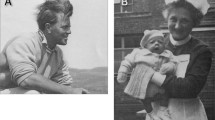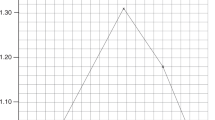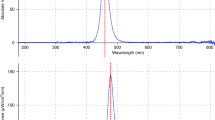Abstract
An observation by an English nurse in 1956 led to the discovery that visible light could lower serum bilirubin levels in newborn infants, and subsequent research showed how photons of light energy are absorbed by the bilirubin molecule converting it into isomers that are readily excreted by the liver and the kidney. Understanding the dose–response effect and other factors that influence the way light works to lower bilirubin levels has led to the effective use of phototherapy and has eliminated the need for exchange transfusion in almost all jaundiced infants.
This is a preview of subscription content, access via your institution
Access options
Subscribe to this journal
Receive 12 print issues and online access
$259.00 per year
only $21.58 per issue
Buy this article
- Purchase on Springer Link
- Instant access to full article PDF
Prices may be subject to local taxes which are calculated during checkout
Similar content being viewed by others
References
Cremer RJ, Perryman PW, Richards DH Influence of light on the hyperbilirubinemia of infants Lancet 1958 1 1094–7
Dobbs RH, Cremer RJ Phototherapy Arch Dis Child 1975 50 833–6
Lucey J, Ferreiro M, Hewitt J Prevention of hyperbilirubinemia of prematurity by phototherapy Pediatrics 1968 41 1047–54
Lucey JF Phototherapy of jaundice 1969 Birth Defects, Orig Artic Ser 1970 6 63–70
Maisels MJ Neonatal jaundice In: Sinclair JC, Bracken MB, editors. Effective Care of the Newborn Infant Oxford: Oxford University Press 1992 p. 507–61
Maisels MJ Is exchange transfusion for hyperbilirubinemia in danger of becoming extinct? Pediatr Res 1999 45 210A
Guaran RL, Drew JH, Watkins AM Jaundice: Clinical practice in 88,000 liveborn infants Aust NZ J Obstet Gynaecol 1992 32 186–92
Valaes T, Koliopoulos C, Koltisdopoulos A The impact of phototherapy in the management of neonatal hyperbilirubinemia: Comparison of historical cohorts Acta Paediatr 1996 85 273–6
Keenan WJ, Novak KK, Sutherland JM Morbidity and mortality associated with exchange transfusion Pediatrics 1985 75 417–21
van de Bor M, van Zeben-van der Aa TM, Verloove-Vanhorick SP, et al Hyperbilirubinemia in preterm infants and neurodevelopmental outcome at 2 years of age: Results of a national collaborative survey Pediatrics 1989 83 915–20
O'Shea TM, Dillard RG, Klinepeter KL, et al Serum bilirubin levels, intracranial hemorrhage, and the risk of developmental problems in very low birth weight neonates Pediatrics 1992 90 88–92
Tan KL The pattern of bilirubin response to phototherapy for neonatal hyperbilirubinemia Pediatr Res 1982 16 670–4
Maisels MJ Why use homeopathic doses of phototherapy? Pediatrics 1996 98 283–7
Maisels MJ Jaundice In: Avery GB, Fletcher MA, MacDonald MG, editors. Neonatology: Pathophysiology and Management of the Newborn Philadelphia: JB Lippincott 1999 p. 765–819
ECRI Fiberoptic phototherapy systems Health Devices 1995 24 134–50
Garg AK, Prasad RS, Hifzi IA A controlled trial of high-intensity double-surface phototherapy on a fluid bed versus conventional phototherapy in neonatal jaundice Pediatrics 1995 95 914–6
Tan KL Phototherapy for neonatal jaundice Clin Perinatol 1991 18 423–39
Holtrop PC, Ruedisueli K, Maisels MJ Double versus single phototherapy in low birth weight newborns Pediatrics 1992 90 674–7
Tan KL Comparison of the efficacy of fiberoptic and conventional phototherapy for neonatal hyperbilirubinemia J Pediatr 1994 125 607–12
Hansen TWR Acute management of extreme neonatal jaundice — the potential benefits of intensified phototherapy and interruption of enterohepatic bilirubin circulation Acta Paediatr 1997 86 843–6
Tan KL, Lim GC, Boey KW Efficacy of “high-intensity” blue-light and “standard” daylight phototherapy for non-haemolytic hyperbilirubinemia Acta Paediatr 1992 81 870–4
Mills JF, Tudehope D Fiberoptic phototherapy for neonatal jaundice In: The Cochrane Library, Issue 1 Oxford: Update Software 2001
Pezzati M, Biagiotti R, Vangi V, et al Changes in mesenteric blood flow response to feeding: conventional versus fiber-optic phototherapy Pediatrics 2000 105 350–3
Seidman DS, Moise J, Ergaz Z, et al A new blue light-emitting phototherapy device: A prospective randomized controlled study J Pediatr 2000 136 771–4
Author information
Authors and Affiliations
Rights and permissions
About this article
Cite this article
Maisels, M. Phototherapy — Traditional and Nontraditional. J Perinatol 21 (Suppl 1), S93–S97 (2001). https://doi.org/10.1038/sj.jp.7210642
Published:
Issue Date:
DOI: https://doi.org/10.1038/sj.jp.7210642
This article is cited by
-
Irradiance footprint of phototherapy devices: a comparative study
Pediatric Research (2022)
-
Exchange transfusion for hemolytic hyperbilirubinemia: could some be averted by emergent administration of an inhibitor of bilirubin production?
Journal of Perinatology (2021)
-
Early formation of bilirubin isomers during phototherapy for neonatal jaundice: effects of single vs. double fluorescent lamps vs. photodiodes
Pediatric Research (2015)
-
Sister Jean Ward, phototherapy, and jaundice: a unique human and photochemical interaction
Journal of Perinatology (2015)
-
Body Temperature Changes of Newborns Under Fluorescent Versus LED Phototherapy: Authors’ Reply
The Indian Journal of Pediatrics (2014)



